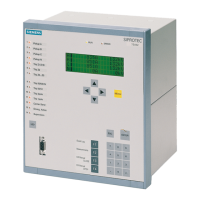Functions
2.10 Automatic Reclosure Function (optional)
SIPROTEC, 7SD610, Manual
C53000-G1176-C145-6, Release date 02.2011
143
Configuration of auto-reclosure
This configuration concerns the interaction between the protection and supplementary functions of the device
and the automatic reclosure function. Here, you can determine which functions of the device should start the
automatic reclosure and which not.
For the functions which should start the auto-reclosure function, the corresponding address is set to YES, for
the others to NO. The other functions cannot start the automatic reclosure because reclosure is not reasonable
here.
Forced 3-pole trip
If a blocking of the auto-reclosure occurs during the dead time of a 1-pole cycle without a previous 3-pole trip
command, the circuit breaker remains open at one pole. With address 3430 AR TRIP 3pole it is possible to
determine that the tripping logic of the device issues a 3-pole trip command in this case (pole discrepancy pre-
vention for the CB poles). Set this address to YES if the CB can be tripped 1-pole and if it has no pole discrep-
ancy protection. Nevertheless, the device pre-empts the pole discrepancy supervision of the CB because the
forced 3-pole trip of the device is immediately initiated as soon as the reclosure is blocked following a 1-pole
trip or if the CB auxiliary contacts report an implausible circuit breaker state (see also Section 2.10 at margin
heading „Processing the circuit breaker auxiliary contacts“). The forced 3-pole trip is also activated when only
3-pole cycles are allowed, but a 1-pole trip is signalled externally via a binary input.
The forced 3-pole trip is unnecessary if only a common 3-pole control of the CB is possible.
Dead line check / reduced dead time
Under address 3431 the dead line check can be switched active. It presupposes that voltage transformers are
installed on the line side of the feeder and connected to the device. If this is not the case or the function is not
used, set DLC / RDT = WITHOUT.
DLC / RDT = DLC means that the dead line check of the line voltage is used. It only allows reclosing after it
has been verified in advance that the line is dead. In this case, the phase-to-earth voltage limit is set in address
3441 U-dead< below which the line is considered voltage-free (disconnected). The setting is applied in volts
secondary. This value can be entered as a primary value when parameterising with a PC and DIGSI. Address
3438 T U-stable determines the measuring time available for determining the no-voltage condition. Address
3440 is irrelevant here.
Adaptive dead time (ADT)
When operating with adaptive dead time, it must be ensured in advance that one end per line operates with
defined dead times and has an infeed. The other (or the others in multi-branch lines) may operate with adaptive
dead time. It is essential that the voltage transformers are located on the line side of the circuit breaker. Details
about this function can be found in Section 2.10 at margin heading „Adaptive Dead Time (ADT) and Close
Command-transfer (Remote-CLOSE)“.
For the line end with defined dead times the number of desired reclose cycles must be set during the configu-
ration of the protection functions (Section 2.1.1) in address 133 Auto Reclose. Additionally, the intertrip
command of the differential protection should be activated (see Section 2.4, address
1301 I-TRIP SEND =
YES). For the devices operating with adaptive dead time, address 133 Auto Reclose must have been set to
ADT during the configuration of the protection functions (Section 2.1.1). Only the parameters described below
are interrogated in the latter case. No settings are then made for the individual reclosure cycles.
Address 3420 AR WITH DIFF, i.e. with differential protection
Address 3421 AR w/ SOTF-O/C, i.e. with high-current switch-onto-fault function
Address 3423 AR WITH I.TRIP, i.e. with permissive underreach transfer trip (PUTT)
Address 3424 AR w/ DTT, i.e. with direct transfer trip
Address 3425 AR w/ BackUpO/C, i.e. with time overcurrent protection

